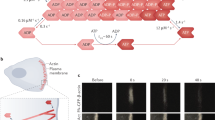Abstract
The motile behavior of non-muscle cells often differs between healthy and pathological conditions. Two disease processes, cancer and atherosclerosis, are associated with high morbidity and mortality in our society. The cells involved in both the pathogenesis of and me defense against these diseases undergo marked changes in the organization of their actin cytoskeletonl1,2. In response to a signal originating from the extracellular space, from surrounding cells, or as the result of a mutation, diseased cells initiate a process of motion away from their normal location. Local growth inhibitors are lost, and displaced cells undergo unchecked proliferation1. One example of such a phenomenon is the migration of fibroblasts and smooth muscle cells into the vascular intima and their proliferation in patients with atherosclerotic coronary artery disease2. Another example is the proliferation of metastatic cells distant from the site of primary tumor1.
Access this chapter
Tax calculation will be finalised at checkout
Purchases are for personal use only
Preview
Unable to display preview. Download preview PDF.
Similar content being viewed by others
References
Van Roy F, Mareel M, Tumor invasion: effects of cell adhesion and motility. Trends Cell Biol. 2: 163 (1992).
Heldman AW, Furman MI, Gardner TM, Gips SJ, Crawford LE, Goldschmidt-Clermont PJ, Coronary artery disease and atherogenesis. in: Molecular Basis of Medicine, Dang CV and Feldman AM, eds., (1993) in press.
Cooper JA, The role of actin polymerization in cell motility. Annu Rev Physiol 53: 585 (1991).
Howard K, Getting there? Curr Biol. 3: 103 (1993).
Luna EJ, Hitt AL, Cytoskeleton-plasma membrane interactions. Science 258: 955 (1992).
Goldschmidt-Clermont PJ, Janmey PA, Profilin, a weak CAP for actin and RAS. Cell 66, 419 (1991).
Friend CM, Catalysis on surfaces. Scientific American 268: 74 (1993).
Yates JT, Surface chemistry. Chemical Engineering News 70: 22 (1992).
Fukami K, Furuhashi K, Inagaki M, Endo T, Hatano S, Takenawa T, Requirement of phosphatidylinositol 4, 5 bisphosphate for α-actinin function. Nature 359: 150 (1992).
Goldschmidt-Clermont PJ, Kim JW, Machesky LM, Rhee SG, Pollard TD, Regulation of phospholipase Cγ1 by profilin and tyrosine phosphorylation. Science 251: 1231 (1991).
Finkel T, Theriot JA, Dise KR, Tomaselli GF, Goldschmidt-Clermont PJ, Actin superstructure promoted by profilin. Proc Natl Acad Sci USA (1993) in press.
Cantley LC, Auger KR, Carpenter C, Duckworth B, Graziani A, Kapeller R, Soltoff S, Oncogenes and signal transduction. Cell 64: 281 (1991).
Goldschmidt-Clermont PJ, Machesky LM, Baldassare JJ, Pollard TD, The actin-binding protein profilin binds to PIP2 and inhibits its hydrolysis by phospholipase-C. Science 247: 1575 (1990).
Machesky LM, Goldschmidt-Clermont PJ, Pollard TD, The affinities of human platelet and Acanthamoeba profilin isoforms for polyphosphoinositides account for their relative abilities to inhibit phospholipase C. Cell Regul 1: 937–950 (1990).
Engel J, Fasold H, Hulla FW, Waechter F, Wegner A, The polymerization reaction of muscle actin. Mol Cell Biochem 18: 3 (1977).
Wegner A, Head to tail polymerization of actin. J Mol Biol. 108: 139–150, 1976.
Janmey PA, Hvidt S, Oster GF, Lamb J, Stossel TP, Hartwig JH, Effect of ATP on actin filament stiffness. Nature 347: 95 (1990).
Pollard TD, Goldberg I, Schwarz WH, Nucleotide exchange, structure, and mechanical properties of filaments assembled from ATP-actin and ADP-actin. J Biol Chem 267: 20339 (1992).
Theriot JA, Mitchison TJ, Actin microfilaments dynamics in locomoting cells. Nature 352: 126 (1991).
Theriot JA, Mitchison TJ, The nucleation-release model of actin filament dynamics in cell motility. Trends Cell Biol. 2: 219 (1992).
Mockrin SC, Korn ED, Acanthamoeba profilin interacts with G-actin to increase the rate of exchange of actin-bound adenosine 5’-triphosphate. Biochemistry 19: 5359 (1980).
Goldschmidt-Clermont PJ, Furman MI, Wachsstock D, Safer D, Nachmias VT, Pollard TD, The control of actin nucleotide exchange by thymosinb4 and profilin. A potential regulatory mechanism for actin polymerization in cells. Mol Biol Cell 3: 1015 (1992).
Carlier M-F, Role of nucleotide hydrolysis in the dynamics of actin filaments and microtubules. Int Rev Cytol 115: 139 (1989).
Cooper JA, Effects of cytochalasin and phalloidin on actin. J Cell Biol. 105: 1473 (1987).
Ridley AJ, Hall A, The small GTP-binding protein rho regulates the assembly of focal adhesions and actin stress fibers in response to growth factors. Cell 70: 389 (1992).
Ridley AJ, Paterson HF, Johnston CL, Diekmann D, Hall A, The small GTP-binding protein rac regulates growth factor-induced membrane ruffling. Cell 70: 401 (1992).
Bourne HR, Sanders DA, McCormick F, The GTPase superfamily: a conserved switch for diverse cell functions. Nature 348: 125 (1990).
Bourne HR, Sanders DA, McCormick F, The GTPase superfamily: conserved structure and molecular mechanism. Nature 349: 117 (1991)
Goldschmidt-Clermont PJ, Mendelsohn ME, Gibbs JB, Rac and Rho in control. Curr Biol. 2: 669 (1992).
Acknowledgements: This research was supported in part by a grant from Syntex, by a grant from the Bernard Foundation and by the American heart Association (G-I-A, Maryland Affiliate, Inc.). PJG-C was selected as a Syntex Scholar in 1992.
Author information
Authors and Affiliations
Editor information
Editors and Affiliations
Rights and permissions
Copyright information
© 1994 Springer Science+Business Media New York
About this chapter
Cite this chapter
Crawford, L.E., Tucker, R.W., Heldman, A.W., Goldschmidt-Clermont, P.J. (1994). Actin Regulation and Surface Catalysis. In: Estes, J.E., Higgins, P.J. (eds) Actin. Advances in Experimental Medicine and Biology, vol 358. Springer, Boston, MA. https://doi.org/10.1007/978-1-4615-2578-3_10
Download citation
DOI: https://doi.org/10.1007/978-1-4615-2578-3_10
Publisher Name: Springer, Boston, MA
Print ISBN: 978-1-4613-6102-2
Online ISBN: 978-1-4615-2578-3
eBook Packages: Springer Book Archive




